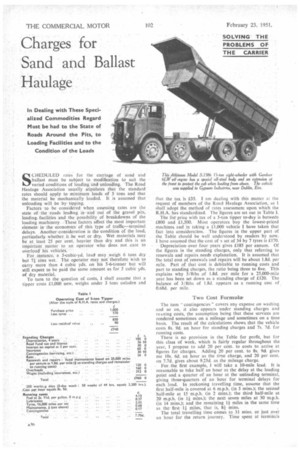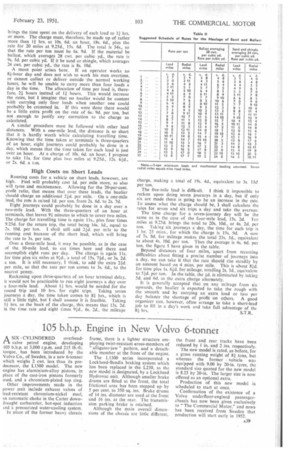Charges for Sand and Ballast Haulage
Page 54

Page 57

If you've noticed an error in this article please click here to report it so we can fix it.
In Dealing with These Specialized Commodities Regard Must be had to the State of Roads Around the Pits, to Loading Facilities and to the Condition of the Loads
SCHEDULED rates for the carriage of sand and ballast must be subject to modification to suit the varied conditions of loading and unloading. The Road Haulage Association usually stipulates that the standard rates should apply to minimum loads of 5 tons and that the material be mechanically loaded. It is assumed that unloading wilt be by tipping.
Factors to be considered when assessing rates are the state of the roads leadtng in and out of the gravel pits, lOading•facilities and the possibility of breakdowns of the loading machinery. •These factors affect the most important element in the econotmcs of this type of traffic—terminal delays. Another consideration is the condition of the load, particularly whether it..be wet or dry. Wet materials may be at least 25 per cent, heavier than dry and this is an important matter to an operator who does not .care to overload his vehicles.
For instance, a 5-cubic-yd. load may weigh 6 tons dry but 71 tOns wet. The operator may not therefore wish to carry more than 4 cubic yds. on his 5-6-tonner but will still expect to be paid the same amount as for 5 cubic yds. of dry material. To turn to the question of costs, I shall assume that a tipper costs £1,000 new, weighs under 3 tons unladen and that the tax is £35. I am dealing with this matter at the request of members of the Road Haulage Association, so l shall adopt the method of rates assessment upon which the R.H.A. has standardized. The 'figures are set out in Table!, The list price with tax of a 5-ton tipper to-day is between £800 and £1,500. Most operators buy the lowest-priced machines and in taking a i1,000 vehicle I have taken that fact into consideration. The figures in the upper part of the Table should be well understood by readers by now. 1 have assumed that the cost of a set of 34 by 7 tyres is £170.
Depreciation over four years gives £185 per annum. Of the figures in the standing charges, only that referring to renewals and repairs needs explanation. It is assumed that the total cost of 'renewals and repairs will be about 1.8d. per mile. Part of that cost is debitable to running costs and part to standing charges, the ratio being three to five. This explains why 5/8ths of I.8d. per mile for a 25,000-mile year has been set down as a standing charge of £120. The balance of 3/8ths of 1.8d. appears as a running cost of 0.68d. per mile.
Two Cost Formulw
The item "contingencies" covers any expense on washing and so on, it also appears under standing charges and rtrAning costs, the assumption being that these services are rendered sometimes on a mileage and sometimes on a time basis. The result of the calculations shows that the vehicle costs 8s. 9d. an hour for standing charges and 7s. 7d. for running costs.
There is no provision in the Table for profit, but for this class of work, which is fairly regular throughout the year, I propose to add 20 per cent. to costs to arrive at figures for charges. Adding 20 per cent. to 8s. 9d. gives me 10s. 6d. an hour as the time charge, and 20 per cent. on 7.7d. gives about 9.25d. as the mileage charge.
For the first example, I will take a 10-mile lead. It is reasonable to take half an hour as the delay at the loading point and a quarter of an hour at the unloading terminal, giving three-quarters of an hour for terminal delays for each load. In reckoning travelling time, assume that the first half-mile is covered at 6 m.p.h. (in 5 mins.); the second half-mile at 15 mph. (in 2 mins.); the third half-mile at 20 m.p.h. (in 11 mins.); the next seven miles at 30 m.p.h. (in 14 mins.); and the remaining 1 miles in the same time as thefirst 1 1. miles, that is, Erl. mins.
The total travelling time comes to 31 mins. or just over an hour for the return journey. Time spent at terminals
brings the time spent on the delivery of each load to 1: hrs. or more. The charge must, therefore, be made up of rather more than l hrs. at 10s. 6d. an hour, 18s. 6d., plus the rate for 20 miles at 9.25d., 15s. 6d. The total is 34s., so that the rate per ton must be 6s. 9d. If the material be ballast, which averages 28 cwt. per cubic yd., the rate is 9s. 5d. per cubic yd. If it be sand or shingle, Which averages 24 cwt. per cubic yd., the rate is 8s. 10d.
A moot point arises here. If an operator works an 81-hour day and does not wish to work his men overtime, or cannot collect or deliver outside the normal working hours, he will be unable to carry more than four loads a day in the time. The allocation of time per load is, therefore, 21 hours instead of I. hours. This would increase the rates, but I imagine that no haulier would be content with carrying only four loads when another one could probably be crammed in. If this were -done there would be a little extra profit on the rate of 6s.9d. per ton, but not enough to justify any correction to the charge as calculated.
A similar procedure must be followed with other lead distances. With a one-mile lead, the distance is so short that it is hardly worth while calculating travelling time. Knowing that the time taken at terminals is three-quarters of an hour, eight journeys could probably be done in a day, which means that the time taken for each load is just over an hour. At a charge of 10s. 6d. an hour, I propose to take Ils, for time plus two miles at 9.25d., 12s. 61d., or 2s. 6d. a tan.
High Costs on Short Leads
Running costs for a vehicle on short leads, however, are high. Fuel will probably cost Id. per mile more, as also will tyres and maintenance. Allowing for the 20-per-cent. profit ratio, that means that over these leads, the haulier should charge an additional 21d. per mile. On a one-mile lead, the rate is raised Id. per ton, from 2s. 6d. to 2s. 7d.
Eight journeys could probably be done in a day over a two-mile lead. With the three-quarters of an hour at terminals, that leaves 9f minutes in which to cover two miles. The charge for travelling time is again 1 Is., plus four times 9.25d. for the return trip, the total being 14s. id., equal to 2s, 10d. per ton. I shall still add 21d. per mile to the running cost because of the short lead, which will bring the rate to 3s. per ton.
Over a three-mile lead, it may be possible, as in the case of the 10-mile lead, to cut times here and there and accomplish eight runs per day. The charge is again I Is. for time plus six miles at 91d., a total of 15s. 71d., or 3s. 2d. a ton. It is still necessary. I think, to add the extra 21d. per mile, so that the rate per ten comes to 3s. 6d., to the nearest penny. Reckoning upon three-quarters of an hour terminal delay, it would not be practicable to run eight journeys a day over a four-mile lead. About If hrs. would be needed for the round trip and 10 hrs. for eight trips. Taking seven journeys a day, the time taken comes to 81 hrs., which is still a little tight, but I shall assume it is feasible. Taking lf hrs. as the basis of the charge, this means that 13s. 2d. is the time rate and eight times 91d., 6s. 2d., the mileage charge, making a total of 19s. 4d., equivalent to 3s. 1 Id per ton.
The five-mile lead is difficult. I think it impossible to reckon upon doing seven journeys in a day, but if only six are made there is going to be an increase in the rate. To assess what the charge should be, 1 shall calculate the rates for seven and six trips a day and take the average.
The time charge for a seven-journey day will be the same as in the case of the four-mile lead, 13s. 2d. Ten miles at 9.25d. brings the total to 20s. 10d., or 4s. 2d. per ton. Taking six journeys a day, the time for each trip is 1 lir, 25 mins., for which the charge is 15s. 9d. A sum of 7s. 8d. for mileage makes the total 23s. 5d., equivalent to about 4s. 10d. per ton. Thus the average is 4s. 6d. per ton, the figure I have given in the table.
Beyond distances of four miles, apart from recurring difficulties about fitting a precise number of journeys into a day. we can take it that the rate should rise steadily by an amount based on 4 mins. per mile. This is about 81d. for time plus Is. 61d. for mileage, totalling 2s. 3d.. equivalent to 51d. per Ion. In the table, the Id. is eliminated by taking 5d. and 6d. as the extra charge alternately. It is generally accepted that on any mileage from six upwards, the haulier is expected to take the rough with the smooth and by carrying an extra load or two per day balance the shortage of profit on others. A good organizer can, however, often arrange to take a short-lead job to fill in a day's work and take full advantage of thc 81 hrs. , S.T.R.




















































































